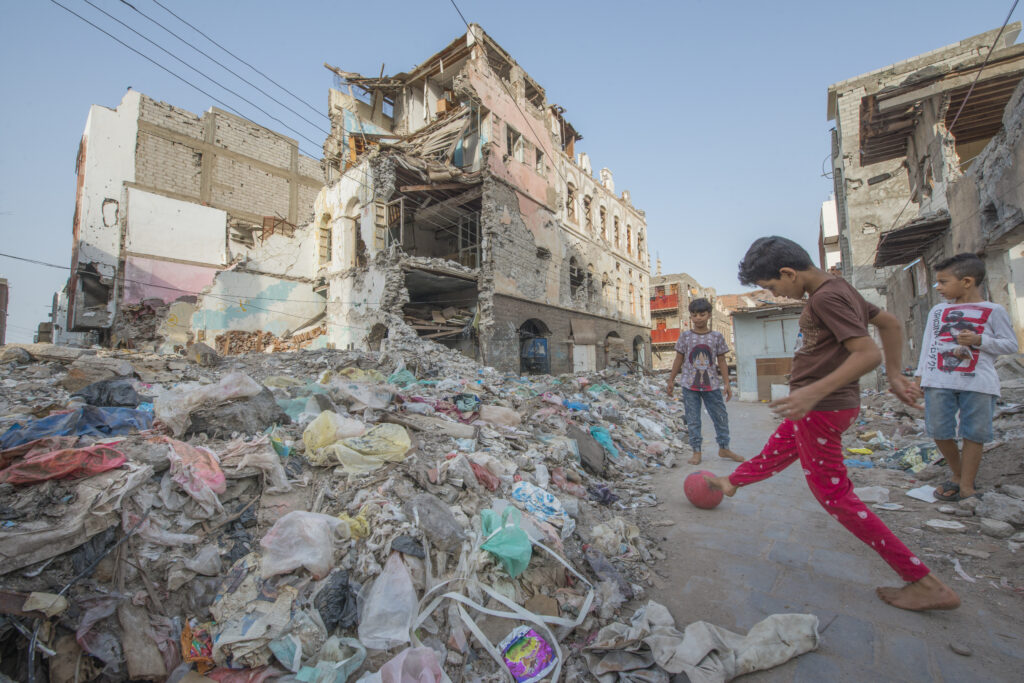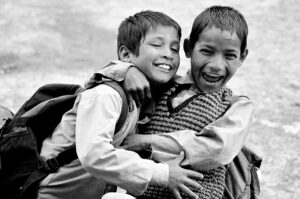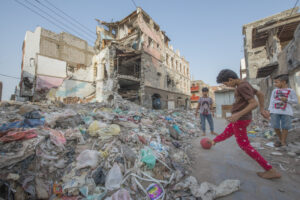The world’s forgotten wars: Yemen
Writer, Archie Sykes, moves into the second part of his series in exploring the world’s forgotten wars. In this part, he writes about the Yemeni civil war.

Image Credit: EU Civil Protection and Humanitarian Aid
The Yemeni civil war has often been called the world’s forgotten war, the neglected sibling of the Middle East wars. Despite this, the events in Yemen are just as important as the other Arab Spring conflicts and the human suffering just as great.
Before the Arab Spring Yemen was governed by authoritarian president Ali Abdullah Saleh who united the country in 1990. In 2011, as protests swept across the entire region, Yemen was no different. Protests started against government corruption, but following crackdowns their nature began to transform into more generally anti-government.
Unlike the leaders of many other regional countries, Saleh agreed not to seek re-’election’ (effectively resigning as these were never free or fair) and requested that the Gulf Cooperation Council work towards a political transition. These negotiations struggled to get off the ground and by 2014 the main opposition group, the Houthis, withdrew from negotiations and rebelled (with the help of Saleh).
Quickly the Houthis managed to take large amounts of Yemen, including the capital Sanna and this forced the new transitional government to flee, to Saudi Arabia. Meanwhile, the instability in the country enabled Al-Qaeda groups to enter the east of the country and establish a territorial base.
By 2015 the Saudi’s concerns with a Houthi government to their south grew sufficient for them to invade the country in March. Although the action was never sanctioned by the UN the government that Saudi Arabia backed in their invasion was, and continues to be, the UN- recognised government and the UN Security Council has supported the goal of defeating the Houthis.
Saudi Arabia was able to take much of the territory in the east of the country, but Sanna (the capital) and the mountainous northwest of the country where the Houthis have their support base has proven impenetrable. Currently fighting inside Yemen there are four main armed groups that participate in the fighting.
The Saudi-backed government now led by President Hadi has been formed out of the transitional government established following the Arab Spring. Consider by the UN as the legitimate government of the region it has received ground support from Saudi Arabia and military aid from NATO members, the UAE and Abu Dhabi. Although supported for many reasons by these nations the two main reasons are Iran and Al-Qeada both of whom Yemen’s allies wish to contain.
Partly allied with the government is the UAE-backed Southern Transitional Council (STC). Born out of early resistance movements against an excessively pro-northern government, the STC took advantage of the instability in the country to restart their fight for greater autonomy and, possibly, independence. Despite some UAE support for the national government, the STC has been their faction of choice in the civil war with the small Gulf State having trained and armed 50,000 soldiers for them. Since 2019 the group has maintained a fragile truce with the Yemeni government with the aim of defeating both sides’ common enemy, the Houthis.
Despite defeats elsewhere across the region, Al-Qeada in Yemen has been able to keep fighting and was the first militant faction to take advantage of the instability following the 2011 protests. Despite not being backed by any of the regional players the group has been able to grow and, previously hold territory. Despite some defeats to Saudi-Yemeni forces the Yemen branch of Al-Qaeda is one the largest groups in their network.
However, the main opposition to the government is not Al-Qeada or the STC, but the Iranian-backed Houthi rebels. Although, a Shi’a group, like other members of the Axis of Resistance the Houthis have their own, unique religious and political ideology. The Houthis are a Zaydi Muslim group that is nominally Shi’a, but remains distinct from the practices and ideas of Twelver Shi’a Islam (the sect in Iran). Zaydi Islam has a long history in the northern mountains of Yemen where it became popular following a failed uprising against the Ummayad caliphate (around 1,500 years ago).
Following the collapse of the Ottoman empire the sect ruled a kingdom in Northern Yemen until 1961 when Egypt backed an Arab nationalist government to seize power, this never removed the movement’s power. The former president, Saleh, was a member of the community. However, following the first Gulf War Yemen began to align itself more with the US and this, alongside corruption, led the Houthi movement to begin to resist the government.
Since the outbreak of the civil war, the Houthis have received extensive, unofficial, support from Iran in the form of political backing, arms provisions and training by the Islamic Revolutionary Guard. Through this, the Houthis have become an important, and relatively successful, member of Iran’s Axis of Resistance against the US and Saudi Arabia. Particularly the cold war-esque politics of the Iran-Saudi relations has brought Saudi Arabia into a costly war with the group in a similar way that Iran had previously been involved in Syria.
Since 2022 the Houthis and the Yemeni government have maintained a fragile truce that has meant that the territory held by both groups has changed very little since the agreement. The rebels hold the northwest, mountainous region alongside the important Hodeidah port that enables them to continue to receive aid from Iran. Meanwhile, the government maintains control of the rest of the country, including the all-important oil fields. The only real shift has been from the government’s successful moves to remove Al-Qeada control from the east which has seen the group face multiple defeats.
Sadly, despite the truce, the conflict has been able to expand. Following the beginning of the war in Gaza, the Houthis (like Hezbollah) announced their support for Hamas and began a campaign of raids and drone attacks against shipping in the Red Sea. In response to these attacks, the US and UK have led the way with airstrikes against Houthi facilities used to carry out these attacks. According to Al-Jazeera as of November, this had amounted to 100 strikes across rebel territory. However, this has yet to succeed in encouraging shipping back into the Red Sea, or to halt the attacks.
Like the Syrian civil war appeared to be, the Yemen war seems to be frozen in time and there is little to say this will change. Saudi Arabia and Iran both have more pressing concerns than engaging in a risky reselection. Saudi Arabia wants to keep focus, and government spending, up on Vision 2030 and the movement away from an oil economy; restarting the war would make investment in the country more risky and may require an increase in defence spending. Meanwhile, Iran and its Axis of Resistance has been humbled by defeats for Hezbollah and Assad, although victory might reinvigorate Iran’s allies, defeat may be more destabilising for both Iran and Hezbollah than any possible gains from the Houthis taking a wrecked country.
Words by Archie Sykes
Sources:
United Nations Foundation — Yemen: A Brief Background https://unfoundation.org/what-we-
do/issues/peace-human-rights-and-humanitarian-response/yemen-a-brief-background/
Council on Foreign Relations — Yemen’s Tragedy: War, Stalemate, and Suffering
https://www.cfr.org/backgrounder/yemen-crisis
Reuters — Who is fighting in Yemen’s war https://www.reuters.com/world/middle-east/who-is-
fighting-yemens-war-2021-12-07/
Britannica — Houthi Movement
https://www.britannica.com/topic/Houthi-movement
Al-Jazeera — UK, US carry out air strikes on Yemen, including Sanaa
https://www.aljazeera.com/news/2024/11/10/uk-us-carry-out-strikes-on-yemen-including-
sanaa
Brookings Institute — Commentary Who are the Houthis, and why are we at war with them?
https://www.brookings.edu/articles/who-are-the-houthis-and-why-are-we-at-war-with-them/






